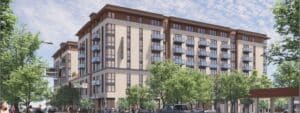Just last week the Metropolitan Transportation Commission released a second draft of the OneBayArea grant proposal.
Unfortunately, it seems like for every step the Commission took in the right direction, it took two more in the wrong direction. And a few pretty big details are so problematic that the OneBayArea grant is starting to look like a step backwards from the status quo and will actually take us farther from achieving our Plan Bay Area goals, not closer. Here are the biggest issues:
Support for Priority Development Areas
Previously, the region had a handful of different programs dedicated to specific types of projects — a program for bike projects, one to support focused growth and sustainable communities, one to address climate change, and one for local road maintenance. The idea behind the OneBayArea grant was to combine these programs into one program with more flexibility – rather than dedicating dollars to specific types of projects — while directing more of the funds to the right places: Priority Development Areas (places in existing cities and towns, near transit, where cities are planning for sustainable growth). In essence, it would use geographic priorities rather than programmatic priorities. That could have worked out well. Unfortunately, as always, the devil is in the details.
One (baby) step forward: Counties are supposed to spend 70% of their dollars (50% in the northern counties) on projects in PDAs or that support PDAs. That makes some sense; if there’s a bike lane that runs through several PDAs along a corridor, you don’t just want to add the bike lane within the bounds of the PDAs and not connect the areas between PDAs.
Two (giant) steps back: But the current definition of “PDA-supportive” is much too broad. It would “Allow a project to count toward the PDA target if it connects to or provides proximate access to a PDA.” Under that definition, a project to re-pave an entire 25-mile, 4-lane road would count if it touches just one PDA on one end. That definitely doesn’t fit with the region’s goals of supporting focused growth and sustainable transportation.
How to get back on track: MTC should tighten up the definition of “PDA-supportive” to make sure projects meet the intent of the grant (add more geographic focus) or allow only bike, pedestrian, or transit projects to fit the “PDA-supportive” bill (restore some programmatic focus).
Support for cities doing the most for sustainable, equitable development
The OneBayArea grant is the main tool to support cities that are doing sustainable, equitable development in places near transit.
One (pretty big) step forward: Thanks to hard work by Greenbelt Alliance and our allies, the revised version of the funding formula for the grant program rewards those counties that do the best job building affordable homes. And we were glad to see that cities are still required to have an adopted and approved Housing Element in order to be eligible for funds.
Two steps back: But funding is distributed to counties based on the aggregate actions of all the county’s cities taken together, which washes away differences between cities in a given county. We all know that land-use decisions about where to grow and how many affordable homes to build are made at the local level, by cities. Local governments play a major role in whether or not affordable housing gets built, so cities that have built more affordable housing should be rewarded. Unless cities see that their actions are linked to funding, they’ll be less likely to do the right thing.
And right now, county Congestion Management Agencies can distribute funds to cities with very few links to specific city actions. The current version of the grant removes any reference to cities’ policies around affordable homes and preventing unwanted displacement of low-income residents. And there’s no requirement that CMAs look at a city’s past performance on sustainable, equitable growth when making grants.
How to get back on track: MTC should establish some basic criteria to be used in distributing funding to cities, e.g. by the CMAs. For example, past affordable housing production should be used to allocate funding both at the county and SUB-county level and MTC should reinstate local affordable housing and anti-displacement policies as one way for cities to qualify for funding. At a minimum, MTC should establish now clear expectations for additional criteria at the city level that will be used for future rounds of grants.
Conservation grants for rural areas
We are thrilled that MTC, for the first time, is proposing a $5 million pilot grant program for land conservation.
One step forward: The new proposal explicitly opens up the conservation grant program to acquisition of land and easements. It also calls for prioritizing projects that will leverage funds from other agencies and philanthropic foundations – great news, because the Coastal Conservancy and the Moore Foundation have both expressed interest in doing just that.
Two steps back: Unfortunately, the proposal also opens up the grant program to “farm-to-market” and “open space access” projects. Now we of course support making it easier for farmers to bring their food to consumers, and easier for residents to get to parks. But unless these projects are carefully defined, we’re concerned these funds will basically be used for road maintenance, in the theory that every road could be on a path from some farm to some consumer, or some resident to some park.
How to get back on track: MTC should ensure that all projects funded by the conservation grant program meet real conservation goals, rather than be used for road maintenance. At a minimum, MTC should clearly define criteria for which farm-to-market and open space access projects will be eligible for the grants.
Unless these issues are addressed, the grants may actually turn out to be more of a loss than a gain for sustainability and equity.




